| |
|
General
Information about Botswana
(Deutscher
Text) |
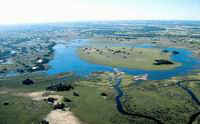 Botswana is roughly the size of France at 581 730 kmē and was known as Bechuanaland until
1966. Botswana is a landlocked country, in the centre of southern Africa, bordered by
Zimbabwe in the East, South Africa in the South and Southeast, Namibia in the West and
North, as well as Zambia in the North.
Botswana is roughly the size of France at 581 730 kmē and was known as Bechuanaland until
1966. Botswana is a landlocked country, in the centre of southern Africa, bordered by
Zimbabwe in the East, South Africa in the South and Southeast, Namibia in the West and
North, as well as Zambia in the North.
Botswana is well known for its undisturbed wilderness, wild life and political
stability.
80% of Botswana consists of the Kalahari, a sand filled basin formed millions of years
ago.
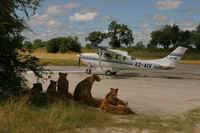 Botswana is generally a very flat land, with an average elevation of 1000 m above sea
level.
In the northwest the Okavango River, originating in Angola and traversing Namibia, forms
the Okavango Delta, covering an area of 15 000 kmē, a vast wetland, well-known for its
great diversity of fauna and flora. In rare occasions and after exceptional good rainy
seasons the Delta spills water into the Boteti River, feeding the Makgadikgadi Pans.
Botswana is generally a very flat land, with an average elevation of 1000 m above sea
level.
In the northwest the Okavango River, originating in Angola and traversing Namibia, forms
the Okavango Delta, covering an area of 15 000 kmē, a vast wetland, well-known for its
great diversity of fauna and flora. In rare occasions and after exceptional good rainy
seasons the Delta spills water into the Boteti River, feeding the Makgadikgadi Pans.
Other important rivers are the Chobe and the Limpopo rivers on the northern and southern
borders respectively. These are also the main water resources of Botswana, generally a
very arid country.
Botswana's capital is Gaborone, with a population of 250 000, and situated in the
southeast close to the border with South Africa.
History:
 The San (Bushmen) and the Khoi were the earliest inhabitants of Botswana. About 40 000
descendants still live in the country.
The San (Bushmen) and the Khoi were the earliest inhabitants of Botswana. About 40 000
descendants still live in the country.
During the 3rd century AD the Bantu people, cattle breeders and
craftsmen, migrated from
central Africa to Botswana.
The Bantu group known as the Tswana migrated from present-day South Africa sometime in the
14th century to colonise the country's southeastern parts. Today they form Botswana's
largest population group.
Early Christian missionaries arrived in 1817, and the first white settlers followed soon
thereafter. From the late 1820s the Boers from the Cape Colony entered Botswana and
claimed land for themselves. The people of Botswana were then informed that they now are
subjects of the South African Republic.
The Tswana leaders Sechele I and Mosielele refused to accept the white rule and requested
protection from the British Empire.
1885 Botswana was proclaimed as the British Protectorate of Bechuanaland.
The British South Africa Company (BSAC) of Cecil John Rhodes became a new threat to the
Tswana Chiefs.
Again Botswana sent a delegation under the leadership of Chief's Bathoen, Khama III and
Sebele to Britain to appeal directly to colonial Minister Joseph Chaimberlain for
continued government control but their pleas were ignored.
At this stage, the chiefs grudgingly accepted that Christianity and Western technology
would affect their rites and traditions.
In 1924 South Africa began pressing for Bechuanaland's amalgamation into the Union of
South Africa. When the Tswana chiefs refused, economic sanctions were imposed on the
country.
As heir to the Ngwato chieftainship Seretse Khama studied law in Britain after World War
II. Here he met Ruth Williams and got married to her in September 1948. This breach of
tribal custom infuriated the entire tribe and Seretse Khama was exiled in
Britain.
In 1956 after renouncing his right to power, he was permitted to return to Botswana with
his wife and set up residence.
1960 the "Bechuanaland People's Party" (BPP) was formed.
The more moderate "Bechuanaland Democratic Party" (BDP) under the leadership of
Seretse Khama and Ketumile "Quett" Masire was formed.
The first general elections were held in 1965 and on 30 September 1966 the
country, now
called the Republic of Botswana, peacefully gained its independence with Seretse Khama as
president.
As a land-locked country, Botswana depended greatly on the economy and transportation
services of its neighbouring country South Africa.
The discovery of diamonds near Orapa in 1967, as well as the mining of coal and copper
economically transformed Botswana and brought wealth to the country and it became less
dependent on South Africa.
1976 the Pula, Botswana's own currency was introduced.
Despite many economical crises Botswana remained a politically stable
country.
Sir Seretse Khama remained Botswana's president until he died in 1980.
Dr Quett Masire succeeded him and retired in from this post in 1998.
Festus Mogae took the helm in March 1998, and is currently Botswana's
president.
Population and People: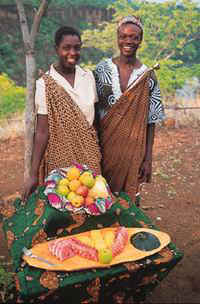
The population is about 1,6 million, one of the lowest population densities in
Africa,
roughly 2 people per square kilometre.
Botswana has one of the world's most predominantly urban societies. The highest population
density is found in the southeastern parts of the country between Francistown and
Lobatse.
About 60% claim Tswana heritage. Other groups include the Herero,
Mbukushu, Yei, San,
Kalana and Kgalagadi, who live mainly in the west and northwest of the
country.
A small number of Europeans and Asians live mainly in Gaborone, Maun and
Francistown.
In the 1990s the population growth was about 2% but with a downward
trend.
English is the official language of Botswana and the medium of instruction from the fifth
year of primary school. The most widely spoken language, however, is
Setswana, which is
the first language of over 90% of the people.
Climate:
Botswana experiences extremes in both temperatures and weather.
The rainy season is between September and April, but mostly it only starts raining in
December through to February. The rains are mostly very intense during these
months. The
average rainfall is about 450mm per year, when the highest rainfall can be to 650mm in the
northeast and as low as 250mm in the southwest.
From October to March temperatures soar up to 44°C, the average being 35°C to 40°C
during midday. Night temperatures seldom fall below 26°C.
During winter daytime temperatures are about 27°C, lowering to about 6°C at
night.
Occasionally it drops below freezing point.
Parks: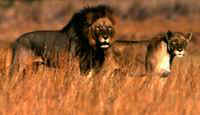
Botswana's national parks are among Africa's wildest, characterised by open
spaces, where
nature still reigns supreme, and although they support a few private safari
concessions,
there is very little infrastructure and few amenities.
Over 17 % of the country has been set a-side as game reserves and national
parks.
The major parks include the Central Kalahari Park (52 800 kmē), Chobe National Park
(10 689 kmē), Moremi Park (4871 kmē), Khutse Park (2590 kmē), Kgalagadi Transforntier
Park, Makgadikgadi (4900 kmē) and Nxai Pan National Park (2578 kmē).
The Tuli Game Park is made up of several private game and nature parks.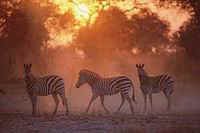
The Chobe National Park is well known for its high concentration of game at the Chobe
River in the dry season, especially for its abundance of elephants, for its huge herds of
buffalo, the Chobe bushbuck and the Puku.
However, the game is not confined to this area, as artificial waterholes keep the game in
the Savuti area as well. This area is especially known for spectacular sightings of
elephant, lion, and hyena and for its magnificent scenery.
The Moremi Park forms an intricate part of the Okavango delta, comprising permanently
swamped areas, seasonally swamped areas and dry land. It is probably the prime tourist
destination in Botswana.
Moremi is a prime wildlife area where elephant, hippo, buffalo, lion and antelopes can be
seen in abundance.
Wildlife management areas where utilisation is strictly controlled surround Moremi Game
Reserve.
Activities offered in the park and surrounding wildlife management areas include game
viewing, boat trips, fishing and mokoro trips in incredible scenery.
The bird life in the Delta as well as in the savannah dry lands is diverse and abundant
and up to 540 species has been recorded.
 Economy: Economy:
Aided by stable politics and vast natural resources, Botswana has
experienced fast growing economic rates (between 11% and 13%).
Mineral resources, especially diamonds mined at Orapa, Jwaneng and
Letlhakane accumulates the main income. At Selebi-Phikwe copper and
nickel are mined, gold around Francistown, a little coal near Palapye,
and soda ash and salt are extracted from the Sua Pan.
Tourism is highly significant as an earner of foreign revenue. Because
of the vast unspoiled wilderness Botswana ranks among the prime
tourist destinations in Africa.
17% of its total surface is put aside for game reserves and parks, and
a policy of high-cost low-volume is applied.
The next biggest industry is the beef industry. The biggest
beef-processing plant is found at Lobatse. Despite severe drought and
diseases, this is still one of the most import revenue earners, as
much of the beef is exported to the EU.
Other agricultural products are sheep, goats, fish, ostrich, crocodile,
maize, sorghum, beans, peanuts and cottonseed, mainly used locally.
About two third of the population are employed in the agriculture
sector.
Although Botswana is one of Africa's wealthiest countries, a big gap
between high and low income exists, as well as a high rate of
unemployment is experienced.
Infrastructure:
Due to the low population rate infrastructure in Botswana is limited.
18 000 km of road of which about 4 000 km are tarred do exist in Botswana.
The only railway line in the country is in the eastern part, from Ramatlabana in South
Africa to Ramokgwebana at the boarder to Zimbabwe. This once formed part of the
Johannesburg - Bulawayo route.
Well-equipped airports are found at Gaborone, Francistown, Maun and
Kasane.
Most of the lodges, camps and tourist attractions are only reachable by charter
flights.
Many of the far off villages are extremely difficult to reach.
Entry Requirement:
Generally, all visitors must have a valid passport. Most visitors from Commonwealth and
European countries do not need a visa. Before travelling we advise you to check the latest
entry requirements with your travel agent or local authorities.
Health requirements:
Yellow fever certificates are only required if you enter Botswana from a yellow fever
country.
In Botswana malaria is wide spread and do we strongly recommend travellers to take the
necessary precautions.
Currency:
The Pula is Botswana's unit of currency. Most hotels, lodges, camps, air charter companies
and safari operators accept US Dollar and the Euro, as well as most credit
cards.
What to pack:
Take light, loose-fitting clothing. Earthy tones are important for walking safaris in
order to blend in with the surroundings. As it can get very cold at night in
winter,
warmer clothes are essential.
Other important items that you would need: hat, sunglasses, high-factor
sunscreen,
comfortable walking shoes, binoculars, camera and enough films, torch, insect
repellent.
Most of the lodges and camps offer a same-day laundry.
|
| Information about
the author: |
|
Heidi van Eck founded Sunbird Tours, a Namibian tour operator, in October 1997.
SUNBIRD TOURS is small company specializing in individual and personalized tours for fly-in safaris, guided and self-drive tours.
Heidi van Eck, a born Namibian, has been working in the tourism industry since 1976. She has traveled the country extensively. With her well-experienced team of consultants we will craft your vacation into real and practical itineraries, enabling you to relax and enjoy your holiday.
We arrange tailor-made Fly-in Safaris, Individual Tours and Group Tours; book your accommodation, rented car, luxury train, day tours and visits to extraordinary destinations in Namibia, Botswana and Zambia.
The fly-in safaris are conducted in well-maintained aircraft and qualified commercial pilots.
Extensive tours or add-ons to Botswana and Zambia can be arranged.
For our guided groups we use air-conditioned busses, with knowledgeable guides. Tours for specialized groups, e.g. Birder's, fishing or incentive groups can be arranged.
Experience the vastness and beauty of the Namib Desert, the prolific game and bird life in the Etosha National Park and the unspoiled Okavango Delta.
Explore the relative unknown game parks of Zambia, for a real African experience and visit the awesome Victoria Falls.
We will introduce you to Namibia's cultural spectrum and the remarkable tradition of the Himba in the Kaokoland and the earliest known inhabitants of Namibia -
the Bushmen (San).
Cross the path of the "Big 5" in the African wilderness of Namibia, Botswana and Zambia.
Combine an unmatched contrast of the endless vastness of the Namib Desert and the profusion of wild life in the Okavango Delta.
Let us show you the essence of Africa, a treasure chest waiting to be
discovered,
with endless possibilities.
Take home memories that will last forever.
For more information please
visit our website
Sunbird
Tours Namibia |
| Weather
Forecast for Botswana: |
|

This Weather forecast is a service of
Wetter-Online.de
|
|